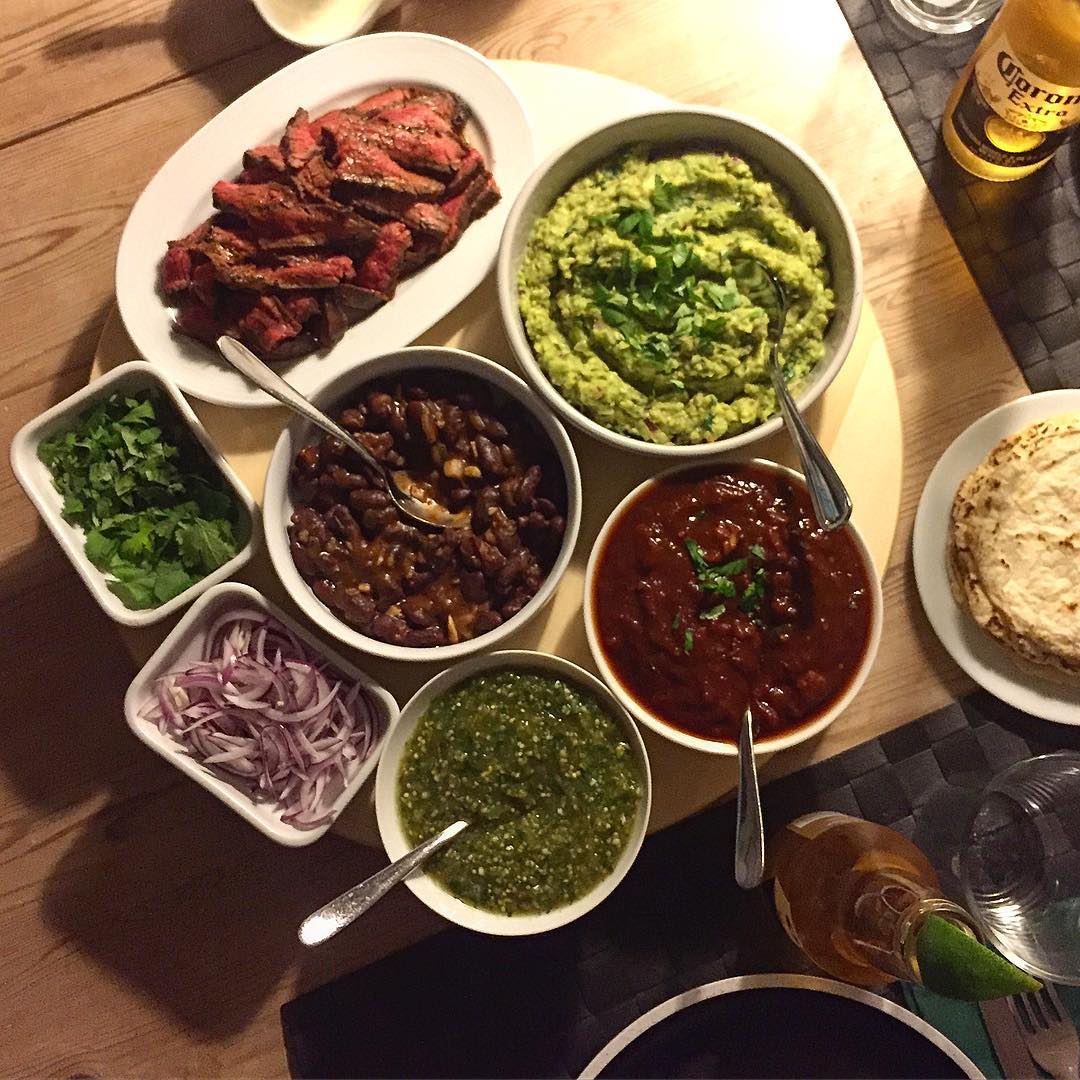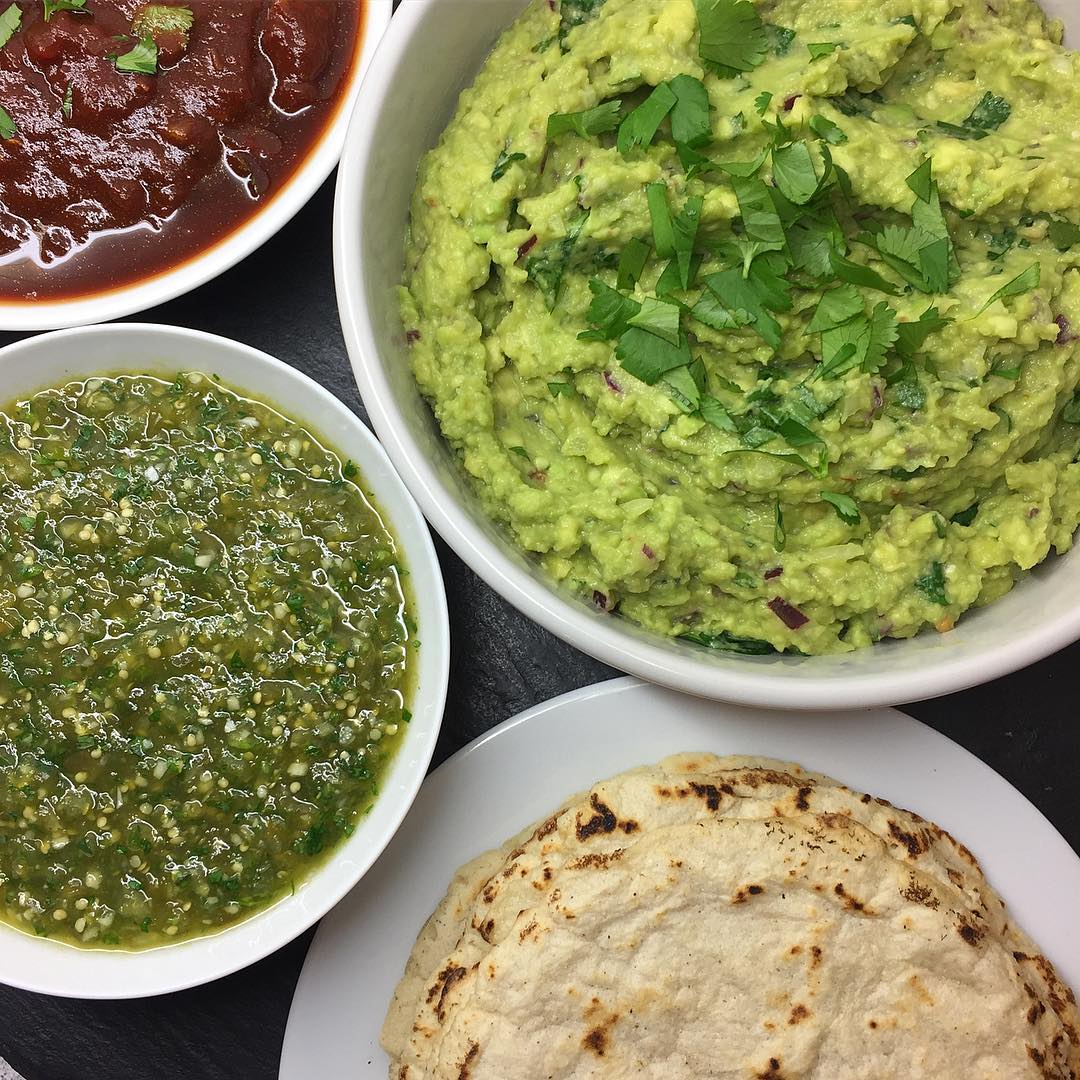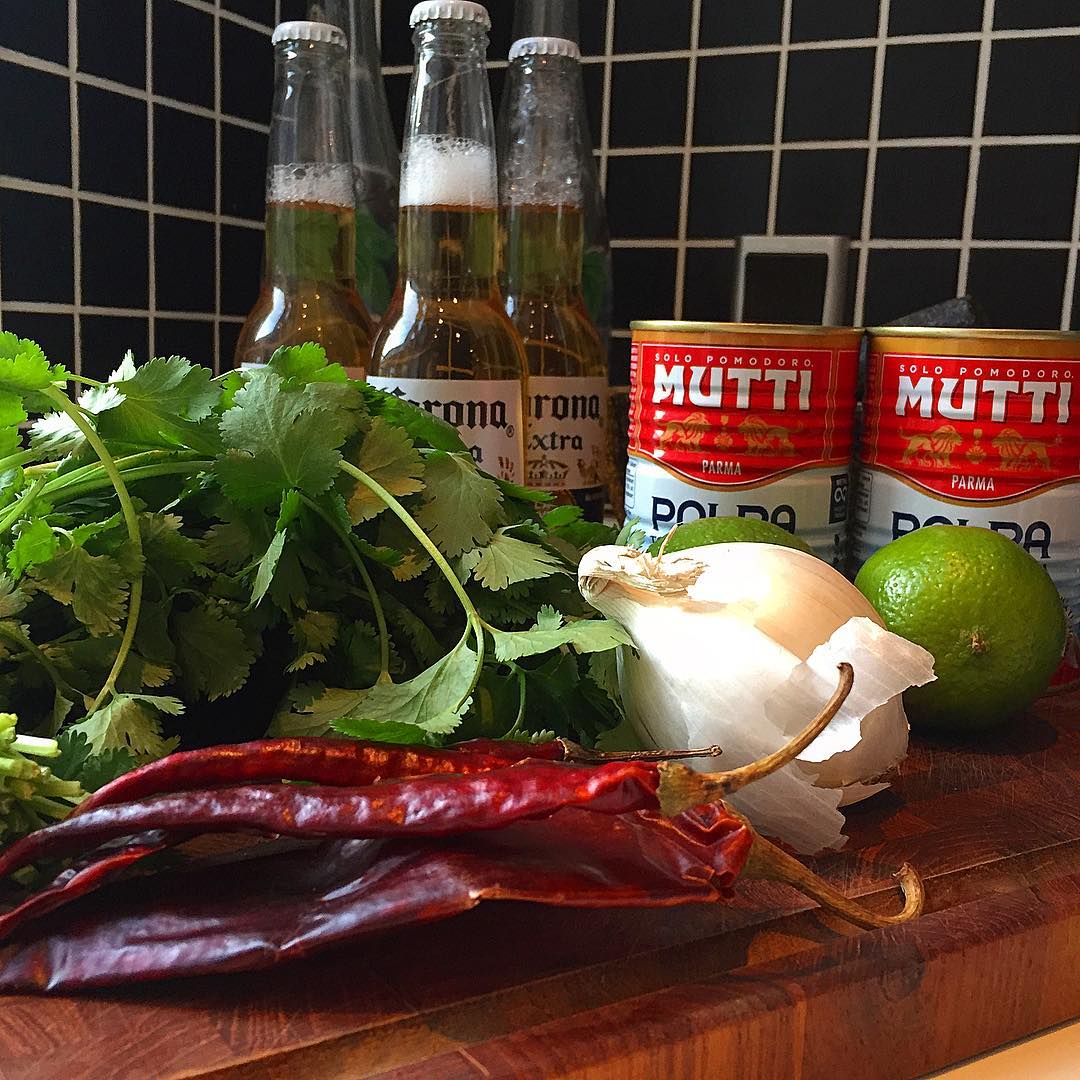Salsa Roja – The perfect Mexican Condiment. That was the working title of this post which was to center on the most flavorful and versatile of Mexican condiments: Salsa roja!

Not many paragraphs into the introduction, the working title warped into something more along the lines of “Mexican Food: A Love Affair!”. When, a few more paragraphs into the original article, I realized that one post was simply not enough to detail my admiration for Mexican food culture: I threw the question up on my Instagram: “Should I do an entire beginner’s guide to Mexican Food?”
The answer was a resounding “Oh FUCK yes”, coupled with a few cries of “do you deliver?” and “will there be a how to get Johan to cook Mexican food for you guide?” … So, friends, here we are…
Don’t worry, if all you really want (you really, really want) is the perfect recipe for the best salsa you’ve ever had, you can jump to the end of the post by clicking here… If you want a little background and history, read on and enjoy what is – essentially – the greatest love story of my life!
Mexican food: A Love Affair
I fell in love with Mexican food during a 2003 trip to California. Head over heels in love. I’m not talking your Chipotle Mexican Grill nonsense or your Taco Bell Tex Mex disgrace, I’m talking the sight and sounds of your host family’s Latin American sister-in-law chopping up wine-ripened tomatoes and fresh Jalapeños for Pico de Gallo on Thanksgiving. I’m talking pounding Coronas with Rudy all day and talking cultural differences, dreams and life in general. I’m talking the sound of Mariachi bands playing tableside in a side alley eatery near LA’s historic Olvera Street. The banging of pots from the stuffed taqueria kitchen. The smell of the spices hitting the heat of the stove… I love Mexican food. The authentic kind of Mexican food that few of us get to experience and shockingly many of us never knew existed… THIS, the authentic and the real, I love it!
Many people, not only in America but certainly across the globe have a warped perception of Mexican food. They either draw a likeness between Mexican food and Tex-Mex or they overly simplify things. Firstly, Tex Mex is not Mexican Food! Tex Mex is American food, made in America by either Latin American or American chefs drawing influences from a combination of American, Mexican and Latin American dishes. Now calm down, children, I’m not saying that proper Tex Mex is inferior to real Mexican food, I’m saying it’s a totally different animal altogether.

Nachos, I love you as much as the next food blogger – but you’re Tex Mex, not authentic Mexican cusine!
Where I do get to gripes with Tex Mex is at the issue of over-simplification! Modern Tex Mex franchises have drawn an image of “Mexican food” being quick, relatively simple, hot and spicy fare served with a pitcher of watery Margaritas: Que Pasa, Amigos?
In reality, Mexican food is ANYTHING but simple: It’s fresh corn tortillas baked to order and served either crisp or soft. It’s crisp vegetables and other fresh ingredients mixed with meticulously prepared multi-layered sauces made from a multitude of ingredients. It’s carefully marinated and perfectly cooked meats served with tantalizing sides that sometimes rival the cuisine of India in terms of complexity and layers… Really, all in all, its thousands of years of culinary history, culture and technique boiled into the perfect comfort and party food. And all the world is thinking about when hearing the words Mexican food are nachos and hard-shell tacos! For shame!
Ever since my return from California, I knew Mexican Food was something I had to perfect at home. A noble cause since I knew next to nothing about cooking back then and had no idea about procurement and use of special ingredients. For nearly 15 years, though, I have tried. For nearly 15 years I’ve experimented, failed, learned my lessons and adjusted… To a point where I now feel reasonably confident doing what I joked about upon leaving sunny Southern California: Writing a Beginner’s Guide To Mexican Food.

Now THIS is more like it…
Walk with me, friends. Let’s take a minute (okay, let’s take several hours!) celebrating the wonder that is (reasonably) authentic Mexican food! I swear, if you hear me out here, you’ll never want to go back to the inferior version that fast food franchise and supermarket shelves offer!
What is Authentic Mexican Food?
Mexican cuisine is a vast and incredibly complex culinary area encompassing thousands of local styles and thousands of years of culinary innovation. Consequently, it’s probably easier to say what Mexican food is NOT: Mexican food is not nachos, hard shell tacos, fajitas or chili con carne. While their ingredients and components may be Mexican in origin, those are all (wonderful) Tex Mex dishes and consequently not part of this guide!
Mexican Food, on the other hand, is a hearty mix of original Mesoamerican cooking and European influences, primarily Spanish, brought over by the Conquistadores. All mixed through hundreds of years of tweaking to form the rough, essential outline of Mexican food that we have today:
An incredibly rich, diverse and shockingly complex kitchen defined mainly by its large variety of sauces and its dependence on native foods such as corn, beans, avocados, tomatoes and chili peppers mixed with an influx of new European food items: rice, meat from domesticated animals, dairy products (even Mexicans love cheese!), herbs and spices.
Mexican food, essentially, mirrors the country of Mexico itself: a proud indigenous culture attempted destroyed by an overpowering invading force but managing to somehow withhold enough principles and key elements to remain entirely its own while becoming something decidedly new: A mix of tradition and innovation all stirred up in a melting pot for some 500 years to create flavors that are neither Mesoamerican nor Spanish, but decidedly Mexican: hearty, comforting, powerful, colorful and full of spice!
And now a white boy from Scandinavia wants to tell you how to cook Mexican Food? Yeah, listen, I know how silly that sounds. But here’s the thing. Mexican food is as much of a state of mind as it is a type cuisine: it’s about forgoing the shredded cheddar cheese, the hard-shell tacos, the ground beef and the spice mixes. It’s about exploring the ingredients and key elements of the Mex part of the Tex Mex equation and about producing something that would be recognized as original and not foreign. And in my 15 years of research, I believe I’ve achieved just that.

Mmm… Tacos… The best street food ever?
Bear in mind that Mexican Cuisine is an overwhelmingly large subject. In this series, we’ll shy away from the most complex of dishes and stick with some basic sauces, staples and dishes. They will be familiar to most, but probably not in the form you will see them here and that’s exactly my idea behind this series: to explore the recognizable in more authentic ways! By Mexican standards, the dishes in this series would mainly be considered street food, and that’s not a bad thing. There’s nothing wrong with street food… Street food is a huge part of Mexican food culture – and hey, tacos are street food!
Getting a hold of Mexican ingredients
As you will notice when we dive a little further into these recipes, Mexican food has a stunning range of somewhat special ingredients. From Masa Harina, the essential ingredient of corn over a wide array of chilies either fresh, dried or ground to Mexican oregano and tomatillos. Some of these may at first glance seem foreign and difficult to come by, but fear not we’ll discuss the individual ingredients as we go and they’ll be easier to come by than you think.
If you live in a town with a noticeable Mexican or Latin American community, chances are you’ll be able to find a specialty store carrying these goods, if not there’s always the good, old, world wide web. Many websites carry and even specialize in Mexican and Latin American ingredients. If you live in Denmark like me, try out chilihouse.dk for example, they’re a great one stop resource and they’re not even paying me to say that!
Keep calm, invest a bit of time and let’s explore the wonderful world of Mexican food, starting with the very, very basics.
Salsa – Sauce and cornerstone of Mexican Cuisine
Salsa is the Spanish word for sauce (and the Italian word for sauce, too, for the bilinguals out there). In modern Mexico, the US and, well, large parts of the world, really, it is generally used a short form expression of salsa picante: a shockingly large group of (you guessed it) piquant sauces ranging in texture from runny over chunky to spreadable and in flavor from mild to brain-numbingly hot.
In reality, though, salsa might as well have been the Spanish word for cornerstone. With a myriad of types, flavors and consistencies to choose from, the Latin American stable is much more than the hot and tangy dip we know from Superbowl parties: It’s an important building block of almost every Mexican meal in more ways than the obvious: Salsa, the world’s perhaps most popular condiment (Salsa is currently outselling ketchup in the United States, just saying!), finds use in the Mexican kitchen not only as a dip but also a relish, a flavor enhancer – even as a base ingredient in other dishes like Huevos Rancheros.

A variety of homemade Mexican salsas
But not only the uses of salsa vary. The various types of salsa is a topic onto itself. The list is basically endless, but some of the most popular salsa varieties include:
Pico de Gallo – a raw hand-chopped variety, often including tomatoes, onion, fresh chilies and cilantro.
Salsa Cruda – an equally raw but often hotter variety of salsa made from much the same ingredients but blended to a saucy consistency.
Salsa Roja – our star of the show tonight! A salsa made from a variety of hot peppers, tomatoes, onions and garlic all of which have been either roasted and/or boiled prior to blending. This makes for a bright red, tasty and superbly versatile salsa that is often served as a condiment at Mexican restaurants but has a million other uses (give or take).
Salsa Verde – a bright green, refreshingly tangy sauce made from tomatillos, green chilies and cilantro. A fresh and not overly spicy counterpart to the predominantly deep and spicy flavors found in Mexican cuisine.
Guacamole – Although often served as a chunky dip, even guacamole is technically a salsa – but let’s not get into that here. Authentic guacamole is definitely a post of its own!
Indeed, salsas are much more than the semi-liquid stuff sold in jars around the world, most of which are basically horribly mistreated types of salsa cruda that have been heat treated then cut with vinegar for longer shelf life – and a horribly metallic, artificial and acidic taste.
No, friends, there’s a world of fresh, exciting salsas out there to discover. So why not start with the best and most versatile salsa in the books?
Is there an authentic Salsa Roja recipe?
Salsa Roja, as stated above is a red salsa in which the ingredients tomatoes, hot peppers, white onions and all have been cooked and blended as part of the preparation. This creates an intensely flavorful, relatively runny salsa perfect for slathering on tacos or using as a dip, but also suitable for many other uses. This versatility has made Salsa Roja a staple at many Mexican restaurants as a table-side dipping sauce, often made fresh in house.
Essentially, this makes Salsa Roja the Mexican equivalent of BBQ sauce: An all-purpose condiment with a secret recipe. Every Mexican grandmother has her own recipe and hence every family their own, “authentic” Salsa Roja recipe. In other words: as with so many other Mexican dishes and sides, there is no authentic, codified Salsa Roja recipe! To each their own! And thank God for that. This is exactly the beauty of this condiment. Every chef can (and should) tweak it to their own liking – as I have done with mine!
Do fresh ingredients make a better salsa?
The perhaps most frequently asked question I get in regards to Salsa is: does freshness of ingredients matter? And while we’re at it: is there a difference between using fresh or dried chilies in salsas and other dishes?
First of all, freshness of ingredients does matter to some extend: a salsa made using fresh ingredients will, not surprisingly, have a fresher, brighter and fruitier flavor whereas a salsa made using canned tomatoes and dried chilies will have a deeper and richer flavor profile. Which should you choose?
It depends! On a bright summer day, nothing quite beats a freshly made pico de gallo salsa using ripe tomatoes, freshly picked chili peppers and a generous squeeze of lime. In places like Denmark, though, where the tomato season is notoriously about seven minutes long, I would show no hesitation in using a trusted brand of canned tomatoes for my salsas and whip them up using a plethora of dried chilies.
What is the difference between fresh and dried chilies?
Dried chilies do not offer the same freshness, fruitiness and immediate punch that fresh chilies do. On the other hand, though, they have a complexity and depth of flavor that fresh chilies simply do not possess: A raisiny, dried fruit sort of quality with a hint of smoked earthiness and a slow, lasting warmth rather than an initial burst of heat. In applications such as Salsa Roja, I much prefer this added depth and complexity as well as the consistency from batch to batch achieved by using a dried product.
Many Americans and Europeans seem to think that when it comes to salsa making, the only chili for the job is the darling Jalapeño, a practice many Mexican cooks have but overbearing smiles in stock for as they reach instead for their trusted Serrano peppers – a strangely similar but much hotter kind of beast. Others swear by Chipotle peppers in Adobo sauce as a Salsa Roja stable, while tough guys reach for top shelf stuff like the entirely too hot Habanero or even Ghost Peppers.

Ladies and gentlemen, I give you the basic ingredients of Salsa Roja!
Me? I like to kick things up a notch and use a slur of different chilies for the specific qualities that they provide. Four to be exact: Ancho chili for its depth of flavor and subtle earthy notes, Guajillo for its sweetness and notes of raisins and dried fruit, Chile de Arbol for a bit of a kick and a sprinkle of chipotle powder for added smokiness and a little more heat.
A note on chili varieties: Mexican cuisine uses a wide variety of chilies with different names and characteristics – most of them essential to the final result of the dish they are used in. You should be able to rather easily acquire the chilies described in this (and future) post cheaply online. If you’re having trouble finding these chilies, I suggest you stick to a mix of Ancho (a mild, fruity variety) and Chipotle (a hotter, smoked variety). Both are readily available and this blend will still lend you quite a bit of the complexity.
Why this meticulous approach to chili picking? Well, for the simple reason that it adds a stunning complexity to the salsa and provides the best possible product: a salsa roja that is at one time bright, fresh, fruity and acidic and at the same time rich, deep and complex in flavor with a noticeable, warming but not overpowering heat profile. This, in my own humble words, make it the PERFECT all-round salsa for every application including dipping, slathering, spreading, cooking or mixing.
And here’s how we do salsa in Johan-land. Or should I say Juan-land?
Salsa Roja: My perfect recipe
Alright, enough talk. Let’s cook! Well, okay, one last thing before we get down to business. Please note that this salsa roja recipe uses whole, dried chilies which is my absolute preferred and highly recommended way of doing things. If, for whatever reason, you would like to use dried, ground chilies instead, you should add them near the end at step #7 in the recipe below.

Salsa Roja - Perfect Cooked Salsa Recipe
Ingredients
- 2 cans diced tomatoes about 800 grams total
- 1 medium white onion
- 1 clove of garlic
- 1 tablespoon Agave Syrup or sugar
- 2 tablespoons olive oil
- 1 small bunch of cilantro
- 1 lime
- 1 Ancho chili dried
- 1 Guajillo chili dried
- 1 Chile de Arbol dried
- 1 teaspoon chipotle powder
- ½ teaspoon Mexican oregano
- salt and pepper to taste
Instructions
-
Remove stems from dried chilies and shake out seeds
-
Carefully toast dried chilies in a dry skillet until warm and fragrant
-
Roughly chop onion, garlic and the toasted chilies then place in a small sauce pan along with about 200 ml of water.
-
Bring chili and vegetable mixture to a boil, lower heat and simmer gently until chilies have softened – about 20-30 minutes.
-
While chilies are simmering, place tomatoes in a colander to drain off excess moisture.
-
Using a stick blender, process chilies, onion and garlic to a thick sauce.
-
In a mixing bowl stir together chili sauce and tomatoes, then add olive oil, Mexican oregano, chipotle powder, agave syrup and the freshly squeezed juice of one lime.
-
Roughly chop leafy parts of the cilantro and add to the salsa as well.
-
Stir everything together, cover and refrigerate for at least an hour.
-
Before serving, season the chilled salsa with salt and pepper to taste. Add a little extra lime juice and/or agava syrup, too, if things seem a little bland.
Recipe Notes
Mexican oregano is a dried herb used in Mexican cuisine. It’s similar in appearance to regular, Mediterranean oregano but is, despite its name, a cousin of lemon verbena rather than a member of the origanum family to which oregano belongs. It shares some of oregano’s unique and pungent earthy flavors and aromas but more subtly so with an added grassy kick of citrus and licorice. Mexican oregano is readily and cheaply available online and adds a unique element to Mexican dishes. If you can’t get Mexican oregano, you can substitute a pinch of marjoram or even regular oregano, just use a little less than the recipe dictates.
And there you have it, salsa Roja, one of the quintessential cornerstones of Mexican cuisine. You’re now ready to dip snacks, make tacos, or cook exciting dishes like Huevos Rancheros. But no rush, your salsa – when properly covered – will keep about five days in the coldest section of your fridge.
Cooking in bulk and looking for long-term storage? Then I’d suggest looking to the canning procedure detailed in this incredible post which will give you a salsa much like those you know from the supermarket, only fresher, more flavorful and tuned to your individual liking.
No patience for such shenanigans? During my latest visit, my culinary playpal Malou from klidmoster.dk brought up the delicate subject of freezing salsa. Would salsa freeze well, she asked. Not really sure what to tell her, I ventured an “uh, maybe, try?” to her question and sort of left it at that. My subsequent research has shown, though, that freezing is a viable and easy alternative to canning but it does seem to lead to a slight loss in appearance and quality. Most noticeably, freezing and thawing of salsa will cause a watery liquid to separate from the solids. If this poses a problem for your desired application, simply drain off any liquid before using or serving.
My suggestions for preservation? Forget about preservation! Grab a jumbo sized bag of nacho chips, invite a few friends, grab a few Coronas from the fridge and dig in… Or experiement with one of the many recipes to come in this series… Stay tuned for more Mexican madness!
Finally, a post that does Mexican cuisine justice!
Thank you very much, Fabiola, that was exactly my intention, I’m glad if I succeeded!
Really great recipe. And very authentic. Will make this again and again
Thanks, Thomas, really appreciate that! 🙂
Hello Johan,
I’ve just discovered your website! Deep joy!
So far I’ve tried your salsa verde and salsa roja, both of which were absolutely fantastic.
Next on the list is going to be carne asada inside enchiladas – I hope that isn’t against the rules.
Be assured I will be continuing to work through your recipes – and I will be recommending you to my friends and relatives.
David, I completely missed this! Thank you so much, I’m glad you like the recipes and appreciate the recommendations… Sometimes we got to make our own rules, right? 🙂